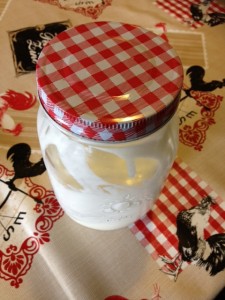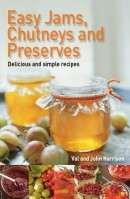Making yoghurt at home is really easy, with no need for a fancy yoghurt maker. All you need is milk, a starter culture, a jar, and some warmth!
There are two ways to make natural yoghurt and it depends on whether you are using standard pasteurised milk or raw (unpasteurised milk).
Standard Yoghurt Making
Ingredients:
- 1 pint milk (ideally full fat/whole milk)
- 2 tablespoons live natural yoghurt or a sachet starter culture
Method:
Heat the milk in a large pan until it reaches 85°C or 185°F, then let the milk cool to 115F while stirring occasionally to stop a skin from forming. Once the milk has reached 45°C, 115°F whisk in the starter yoghurt or culture.
Now to keep it warm. If you have an aga pop it at the back right of the aga; if a conventional oven you can put the pot into the oven with the light on – this gives enough residual heat; you can also wrap it up in a thick towel and place it next to a radiator or any other warm place such as an airing cupboard. Leave the yoghurt to culture and set for 8-12 hours. Once it has set move it to the fridge to cool where it will further firm up.
If you prefer a Greek or thick style yoghurt you can add either milk powder or powdered gelatin at the initial mixing stage. Once chilled you can also strain through a muslin, but don’t discard the whey as that can be used for other recipes or fermentation.
Raw Milk Yoghurt Making
Raw (unpasteurised) milk isn’t for everyone and the NHS warns not to give it to young children, the elderly, those with weakened immune systems, or pregnant women. However, some prefer raw milk and if you do prefer drinking it, making yoghurt with it is really simple too.
Ingredients:
- 1 pint raw milk
- 2 tablespoons natural yoghurt or starter culture
Method:
Heat the milk in a large pan until it reaches 43°C, 110°F. This keeps food enzymes and naturally occurring beneficial bacteria intact and thriving, any hotter and you will pasteurise the milk negating the benefits of using it. Once the milk has reached 43°C, 110°F whisk in the starter yoghurt or culture. I would not recommend adding powdered milk to a raw milk natural yoghurt, but a natural powdered gelatin such as Great Lakes will thicken the culture.
Now to keep it warm you follow the same steps as for pasteurised milk. If you have an aga pop it at the back right of the aga; if a conventional oven you can put the pot into the oven with the light on – this gives enough residual heat; you can also wrap it up in a thick towel and place it next to a radiator or any other warm place such as an airing cupboard. Leave the yoghurt to culture and set for 8-12 hours. Once it has set move it to the fridge to cool where it will further firm up.
Keep Some Back
Don’t forget to keep back two tablespoons of yoghurt from each batch to make your next one with! If you do this you can keep making your own yoghurt without needing to buy any further cultures and all for the cost of your normal milk.
Natural Yoghurt Flavours
I love the taste of natural yoghurt as it is, but for many more used to shop bought and sweetened yoghurts adding a fruit puree or dollop of honey can add a little sweetness to cut into the naturally tart yoghurt. I also love adding a few fresh berries when they are in season.



